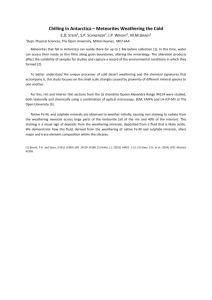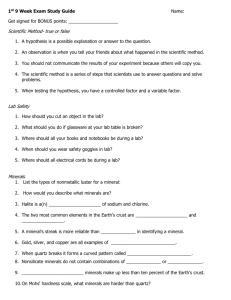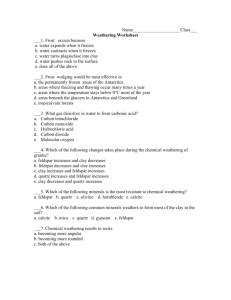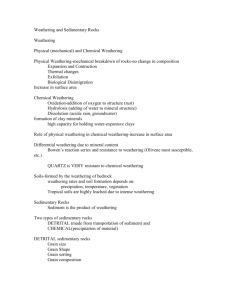Blakeley Jones October 1, 2009 Geology Exam Review Review 3
advertisement
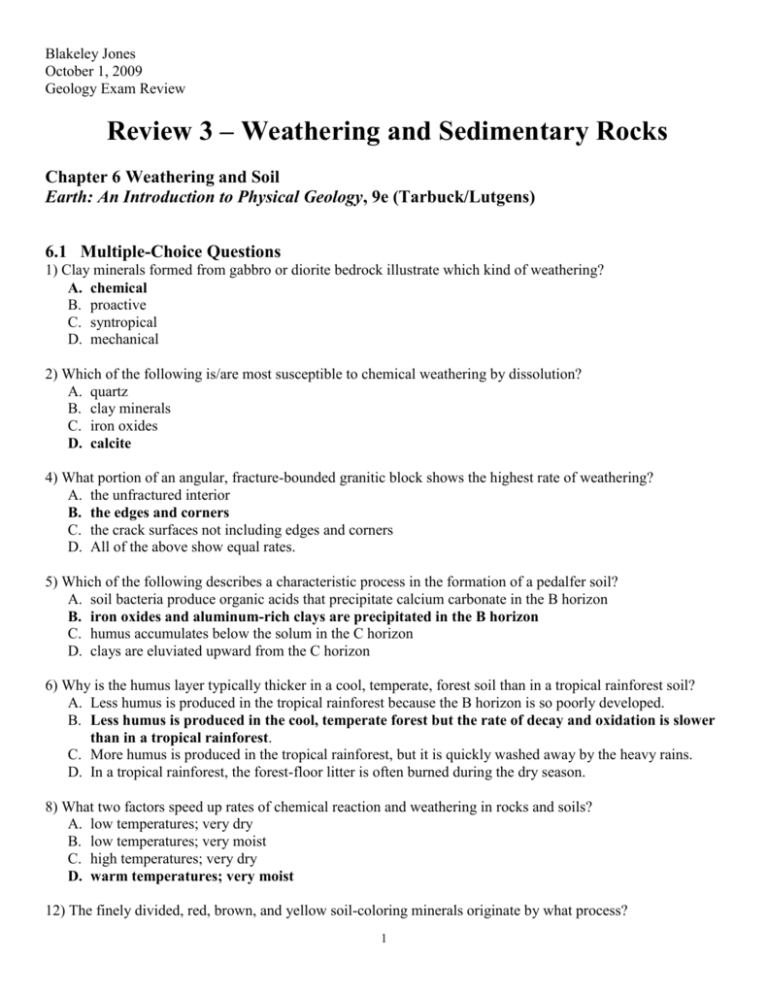
Blakeley Jones October 1, 2009 Geology Exam Review Review 3 – Weathering and Sedimentary Rocks Chapter 6 Weathering and Soil Earth: An Introduction to Physical Geology, 9e (Tarbuck/Lutgens) 6.1 Multiple-Choice Questions 1) Clay minerals formed from gabbro or diorite bedrock illustrate which kind of weathering? A. chemical B. proactive C. syntropical D. mechanical 2) Which of the following is/are most susceptible to chemical weathering by dissolution? A. quartz B. clay minerals C. iron oxides D. calcite 4) What portion of an angular, fracture-bounded granitic block shows the highest rate of weathering? A. the unfractured interior B. the edges and corners C. the crack surfaces not including edges and corners D. All of the above show equal rates. 5) Which of the following describes a characteristic process in the formation of a pedalfer soil? A. soil bacteria produce organic acids that precipitate calcium carbonate in the B horizon B. iron oxides and aluminum-rich clays are precipitated in the B horizon C. humus accumulates below the solum in the C horizon D. clays are eluviated upward from the C horizon 6) Why is the humus layer typically thicker in a cool, temperate, forest soil than in a tropical rainforest soil? A. Less humus is produced in the tropical rainforest because the B horizon is so poorly developed. B. Less humus is produced in the cool, temperate forest but the rate of decay and oxidation is slower than in a tropical rainforest. C. More humus is produced in the tropical rainforest, but it is quickly washed away by the heavy rains. D. In a tropical rainforest, the forest-floor litter is often burned during the dry season. 8) What two factors speed up rates of chemical reaction and weathering in rocks and soils? A. low temperatures; very dry B. low temperatures; very moist C. high temperatures; very dry D. warm temperatures; very moist 12) The finely divided, red, brown, and yellow soil-coloring minerals originate by what process? 1 A. B. C. D. mechanical weathering of very fine-grained, blue-gray clays chemical weathering of quartz and feldspars precipitation of iron oxides during the chemical weathering process mechanical weathering of the feldspars and micas in granite and rhyolite 16) Which one of the following is an important, mechanical weathering process for enlarging fractures and extending them deeper into large boulders and bedrock? A. oxidation B. eluviation C. hydrologic cycling D. frost wedging 17) Which of the following best describes sets of fractures in relatively fresh bedrock, such as granite, that are roughly parallel to the land surface? A. thermal expansion cracks B. sheeting fractures C. hydrolytic failures D. columnar joints 20) Which one of the following statements concerning mechanical weathering is not true? A. reduces grain sizes of rock particles B. allows for faster rates of chemical weathering C. is important in the formation of talus slopes D. involves a major change in the mineral composition of the weathered material 24) Assume that water filling a crack in a rock undergoes cycles of freezing and melting. Which of the following statement is true? A. Water expands as it melts, causing the crack walls to be pushed apart. B. Water shrinks as it freezes, causing the crack walls to be drawn closer together. C. Water expands as it freezes, causing the crack walls to be pushed apart. D. Water shrinks as it melts, causing the crack walls to be pulled closer together. 26) What mineral particles are the dominant coloring agents in reddish, brownish, and yellowish soils? A. soluble potassium and sodium bicarbonates B. humus and calcium carbonate C. very fine-sized, silica and calcite particles D. dust-sized grains of iron oxides 28) In which area would weathering by frost wedging probably be most effective? A. in a moist, tropical forest B. in cool high desert areas C. where the subsoil is permanently frozen D. in moist, temperate climates 30) Lateritic soils form under what climatic conditions? A. warm and moist as in a wet, tropical forest B. cool and relatively dry as in the northern Great Plains of the United States C. hot and dry as in the desert regions of North Africa and Arabia D. moist and temperate as in the northeastern United States 31) Which of the following statements concerning humus is not true? 2 A. B. C. D. is typically found above the B soil horizon consists of decaying and partly decayed leaves and other plant materials is readily leached from the B horizon in weakly acidic, soil solutions is less abundant in wet, tropical, forested areas than in temperate, forested areas 33) Caliche is an excessive accumulation of ________. A. calcite in the E horizon of a pedalfer B. clays in the A horizon of a laterite C. clays in hardpan layers of a pedocal D. calcium carbonate in the B horizon of a pedocal 35) From the land surface downward to the unweathered bedrock, which of the following is the correct order of the different soil horizons? A. 0, A, E, B, C, bedrock B. A, B, C, D, E, bedrock C. E, A, B, C, 0, bedrock D. D, E, C, B, A, bedrock 6.3 True/False Questions 1) T or F: Quartz weathers readily to aluminum-rich clay minerals. FALSE 2) T or F: Abundant moisture and warm temperatures result in high rates of chemical weathering. TRUE 3) T or F: Very fine-grained, iron oxide particles account for nearly all red, yellow, and brown soil colors. TRUE 4) T or F: In pedalfer soils, the B horizon is enriched in calcite and humus. FALSE 5) T or F: Pedocal soils typically form by intense chemical weathering under very cold and wet climatic conditions. FALSE 8) T or F: Sheeting is mainly a process of mechanical weathering. TRUE 9) T or F: Sheeting fractures and exfoliation domes commonly develop in areas with soft, highly fractured bedrock. FALSE 10) T or F: Quartz is quite resistant to weathering and is an important component of sands in riverbeds and on beaches. TRUE 11) T or F: Feldspars commonly decompose during weathering to clay minerals, silica, and soluble constituents. TRUE 13) T or F: Calcite, a major component of some monumental and building stones, slowly dissolves in weakly acidic waters. TRUE 14) T or F: Like most other liquids, water decreases in volume when it freezes. FALSE 16) T or F: Removal of soluble chemical constituents from a soil is termed leaching. TRUE 17) T or F: The material caliche represents an extensive, concrete-like accumulation of calcite in the B 3 horizon of a pedalfer soil. FALSE 19) T or F: Ferromagnesian minerals (like olivine and pyroxene) that crystallize at high temperatures in Bowen's reaction series are generally much less susceptible to chemical weathering than quartz. FALSE Chapter 7 Sedimentary Rocks Earth: An Introduction to Physical Geology, 9e (Tarbuck/Lutgens) 7.1 Multiple-Choice Questions 1) ________, a common mineral found in igneous rocks, is the most abundant mineral in detrital sedimentary rocks. A. Calcite B. Orthoclase C. Quartz D. Biotite Match the sediment with the appropriate rock name. A. sand B. clay and fine silt C. gravel 4) ____A___ sandstone 5) ____B____ shale 6) ____C____ conglomerate 8) Compaction is a very important part of the lithification process for which of the following sediments? A. gravel B. sand C. mud D. cobble 9) A cherty limestone would contain which major constituents? A. iron oxide, calcite B. silica; iron oxide C. clay minerals D. silica; calcite 12) ________ cement produces bright-red and yellow colors in some sandstone. A. Clay B. Calcite C. Quartz D. Iron oxide 13) What is probably the single most important, original, depositional feature in sedimentary rocks? A. sizes of the sand grains B. degree of lithification 4 C. bedding or stratification D. compaction of the mud and clay 18) What is the main difference between a conglomerate and a sedimentary breccia? A. Breccia clasts are angular; conglomerate clasts are rounded. B. A breccia is well stratified; a conglomerate is poorly stratified. C. Breccia clasts are the size of baseballs; conglomerate clasts are larger. D. Breccia has a compacted, clay-rich matrix; conglomerate has no matrix. 19) Which of the following describes the correct order for relative solubility of minerals in sedimentary rocks? A. Evaporate minerals are more soluble than quartz and less soluble than calcite. B. Evaporate minerals are less soluble than quartz and calcite. C. Evaporate minerals are more soluble than calcite and quartz. D. Evaporate minerals, quartz, and calcite all have the same relative solubility. 22) Which type of limestone consists mainly of tiny, marine fossils composed of calcite? A. dolostone B. chert C. coquina D. chalk 23) ________ is not a common cementing agent for sandstones. A. Quartz B. Calcite C. Fluorite D. Iron oxides 24) Detrital sedimentary rocks are classified (named) based on the ________. A. colors of the cementing minerals B. grain sizes of the detrital particles C. compositions of soluble minerals D. degree of compaction and lithification 25) Which of the following applies to the basic constituents of halite, gypsum, and sylvite? A. transported as dissolved ions; deposited as detrital mud B. transported as detrital mud; deposited by evaporation C. transported as dissolved ions; deposited by evaporation D. transported and deposited as mud-sized particles 26) Flint, chert, and jasper are microcrystalline forms of ________. A. quartz (SiO2) B. hematite (Fe2 O3) C. halite (NaCl) D. calcite (CaCO3) 31) Which of the following sedimentary features would typically be found in shales but not in sandstones? A. mud cracks B. cross stratification C. ripple marks D. bedding 5 32) ________ is the most common type of chemical sedimentary rock. A. Limestone B. Chert C. Phosphate rock D. Quartz sandstone 34) Which one of the following is not a chemical sedimentary rock or evaporite? A. shale B. bedded gypsum C. cherty dolostone D. oolitic limestone 38) Which of the following sedimentary features can each be used to determine paleocurrent directions? A. mud cracks and ripple marks B. ripple marks and cross stratification C. fossils and mud cracks D. grain size sorting and ripple marks 39) Coal beds originate in ________. A. shallow lakes in a dry, desert region B. channels of fast-moving streams C. deep, marine basins below wave action D. freshwater coastal swamps and bogs 7.3 True/False Questions 1) T or F: Clay and muddy sediments lithify to form shales and mudstones. TRUE 2) T or F: Detrital sedimentary rocks have clastic textures. TRUE 5) T or F: Clastic particles in a sedimentary breccia are rounded and are about the same size as fine-grained sand. FALSE 6) T or F: Many limestones are of biochemical origin. TRUE 7) T or F: Boulder conglomerates suggest deposition by strong winds in a desert. FALSE 8) T or F: Mud cracks in a shale or mudstone indicate that the mud or clay was deposited in deep waters of an offshore marine environment. FALSE 9) T or F: Chalk, coquina, and ancient coral reefs are primarily composed of microcrystalline quartz. FALSE 13) T or F: Detrital sedimentary rocks are classified according to clastic particle size; chemical sedimentary rocks are named according to the most abundant minerals. TRUE 6

